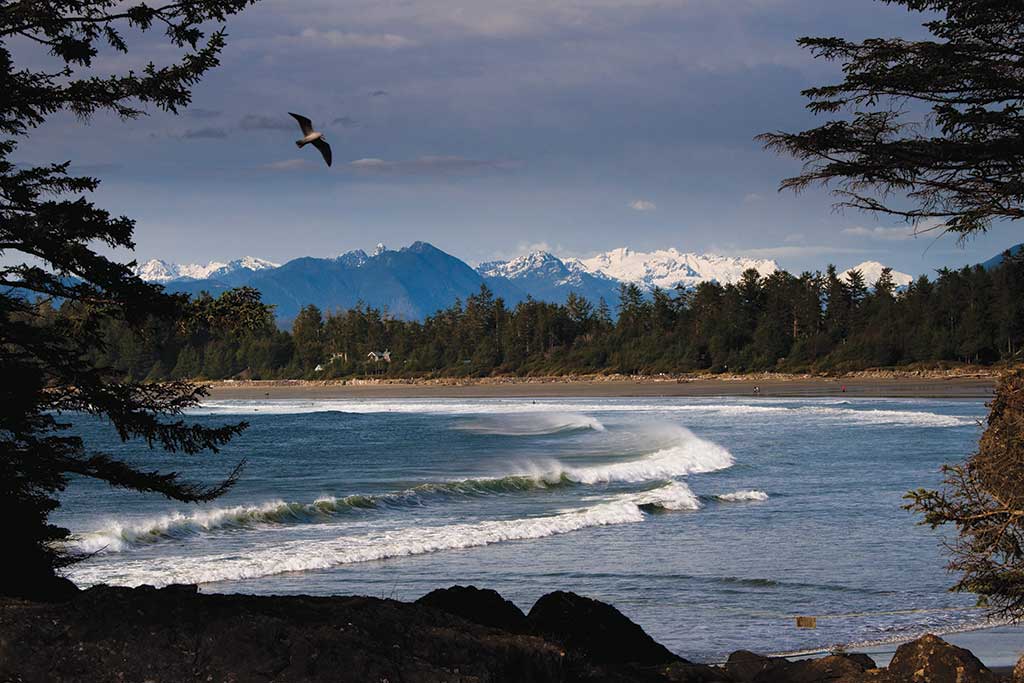Visitors to Tofino spend time ambling boardwalked hiking trails through the impossibly green National Park; walking along the desolate crescents of Chesterman, Long, and McKenzie Beaches, and whale watching. They come here to reconnect with nature.
On the far western shores of Vancouver Island, in a misty rainforest pounded by Pacific surf is Tofino, British Columbia, a town aptly nicknamed The End of the Road. “Whenever I cross the island to come back home, I feel like I’m leaving the world behind.” says Rino Del Zoppo, a gay Tofino resident who manages the gallery of renowned local wildlife painter Mark Hobson.
Del Zopo, 39, is a cheerful bear of a man with a rascally smile and a small silver hoop through his septum. After growing up in Adelaide, Australia, the son of Italian immigrants, he spent most of his 20s immersed in the world of experimental theater, shuttling back and forth between fringe festivals in London, Edinburgh, and Melbourne.
The experimental spirit served him well when, at 32, he decided to take a break from his routine and head to Canada on a two year work permit.
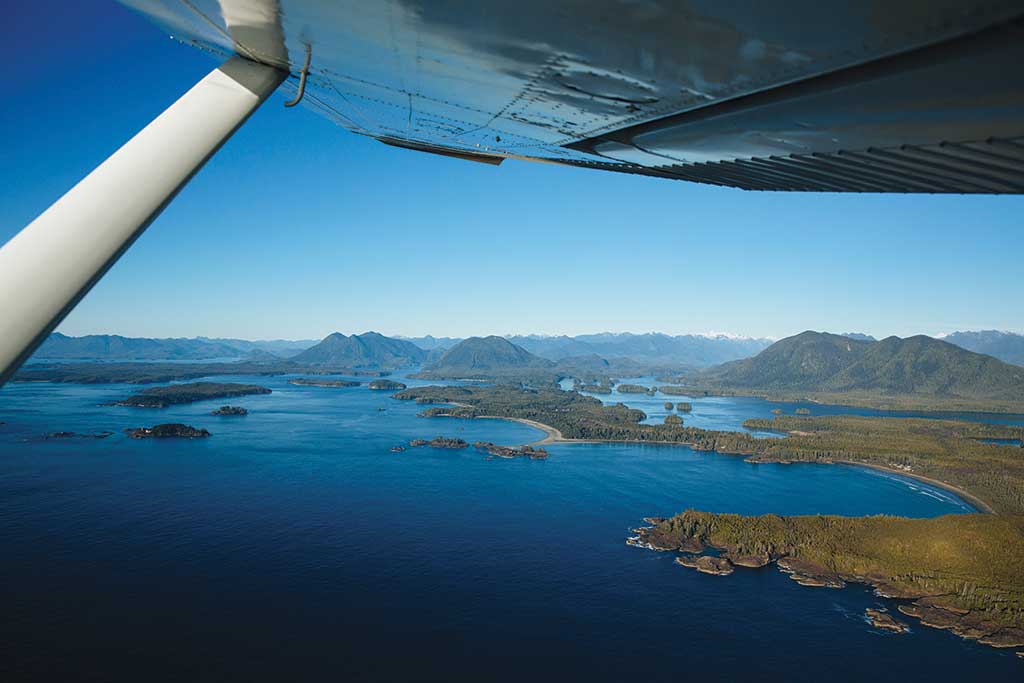
Aerial of Tofino and Clayoquot Sound credit Jeremy Koreski
“I landed in Vancouver on the mainland and ferried over to Victoria,” he recalls, “I met some people there who very enthusiastically encouraged me to visit Tofino. I’d never heard of it, of course. And as a city boy, to be honest, it scared the crap out of me, being so remote. But they made it sound almost mystical.”
In the spirit of adventure and self-challenge, Del Zoppo decided to set apprehension aside and give Tofino a try.
“I got a job helping an artist manage his books and I just started to sense that there was a really supportive community here. The surf culture is what first attracts a lot of people. Some of them just fall in love with the place and want to start a business and stay.”
Given Tofino’s miniscule size and year-round population of 2,000, the number of certified yoga teachers and massage therapists in town is remarkable. The population’s average age is just 34.
With no stops, the drive to Tofino from Nanaimo, on Vancouver Island’s east coast, is a humbling three-hour trip along British Columbia’s Highway Four. (Getting to Nanaimo itself takes about 90 minutes, either by car from Victoria or by ferry from the city of Vancouver, on the mainland.)
But the trip merits a more leisurely pace, windows cracked to let in the gray green atmosphere as the nervous life of cities subsides.
“Everything falls away,” says Del Zoppo of the drive. “It’s strange and sort of magical.”
On my own first drive to Tofino, the mundane began to loosen its grip after just 15 minutes. I pulled over to walk the trails through MacMillan Provincial Park’s Cathedral Grove (www.env.gov.bc.ca/bcparks/explore), a sunbeam-pierced stand of fir, red cedar, and hemlock trees, up to 250 feet tall and 29 feet around.
These thick-skinned survivors (some as many as 800 years old) are rooted in an era long before Europeans colonized North America. Their fallen kin lie beneath them on the forest floor, enshrouded in moss and lichen.
The trees cast a spell, reminding me of my smallness—how little space and time I take up in the scheme of things. It’s a liberating dimunition.
For the length of the trip to Tofino, I’m one of those uncountable dust motes that dance in the slanting rays of forest light, free from the cares of life measured on a human scale.
Beyond Cathedral Grove, Highway Four bends south to the town of Port Alberni, which until late last century was its terminus with only a rough dirt logging route carrying onward to the coast.
In 1972, the highway was extended westerly in a winding, largely two-lane road. The exhilarating drive to Tofino on this road, Canada’s only paved route to the open Pacific Ocean, takes you through the Pacific Rim National Park Reserve, and along the mountain-shadowed shores of Sproat and Kennedy Lakes, where black bears can be spotted fishing for their next meals, before a final 20 mile northward stretch along the coast.
This last leg carries you past the Tofino-Long Beach Airport, an alternate gateway to this isolated territory. Recently, craving Tofino’s soulful solitude, but short on time, I took Orca Airways’ one-hour direct flight from Vancouver (www.flyorcaair.com). I assumed that I’d sacrificed the civilization-shedding pleasures of the cross-island drive, only to discover one of the most spirit-lifting plane rides I’ve ever experienced.
Visibility was high that late autumn day, and the low-altitude flight on an eight-passenger Beechcraft King Air 100 offered panoramic views of urban asphalt and nearby farmland sliding past as we approached the islet-flecked Strait of Georgia. Then came the Vancouver Island’s swaths of evergreen punctuated by ice-blue snowcapped mountains, and a final descent that dramatically revealed the island’s perimeter: thick rainforest suddenly yielding to whitecapped surf.
However you get there, the journey, like the destination, is a wonder.
Tofino sits at the tip of a long finger of land that extends into Pacific-fed Clayoquot Sound. Many of the surrounding islands remain titled homelands for First Nations fishing and hunting communities, native to the area long before European explorers first arrived in the late 1700s.
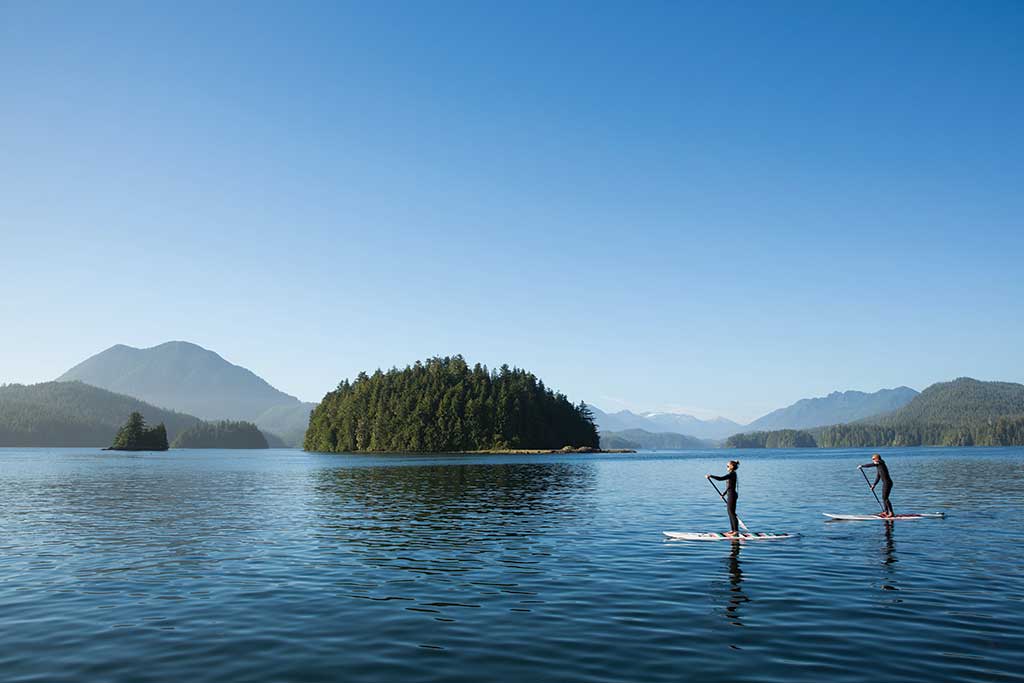

Tofino Inlet credit Jeremy Koreski
For the following century and a half, the settlement was little more than a off-the-beaten path waystation for miners and fur traders. But in 1972, the same road that’s made it easy to visit Tofino as a tourist today spurred the town’s transformation into the hub of a rapacious lumber boom in thousands of forested acres beyond the limits of the national park.
While providing jobs for hundreds of local residents, the clearcutting of the temperate rainforest also posed an ecological threat and incensed the First Nations population.
Beginning in the early 1980s, protests against the government-supported logging industries roiled the region, culminating in the largest act of civil disobedience in Canadian history. Known as the War in the Woods, in the summer of 1993 over 10,000 protestors gathered near Tofino, blockading logging roads for three months in condemnation of the lumber industry. The engagement of high-profile environmental groups, including Greenpeace and the Sierra Club, and public outrage at mass arrests of protestors eventually turned the tides.
Logging rights were limited, major lumber companies abandoned the region, and in 2000, Clayoquot Sound was designated a UNESCO Biosphere Reserve.
Today, the economy of Tofino is driven by those who want to revel in the natural environment, not ravage it. Mayor Josie Osborne, an energetic 42-yearold who first visited the town with her father as a child and returned as a college student of marine biology, says that while travelers are her town’s economic lifeblood (close to a million people visit each year) the locals are committed to ensuring that Tofino never feels like “a tourist town.”
Tofino has no chain stores, no fast food franchises, no movie theater. Visitors spend time ambling boardwalked hiking trails through the impossibly green National Park; walking along the desolate crescents of Chesterman, Long, and McKenzie Beaches, which appear and disappear under rapidly shifting tides; spotting whales from the shore, or from chartered excursion boats; and visiting the local Botanical Gardens (www.tbgf.org) run by George Patterson, the Mayor’s husband, where an impressive sculpture collection includes a major installation incorporating objects carried across the sea and onto Tofino beaches in the wake of the 2011 Japanese tsunami (the gardens have also played host to several same-sex weddings).
“It’s an effort to get here,” adds the mayor, “Nobody’s ‘just passing through.’ So folks who do come really want to be in this environment. They’re my kind of people. They don’t come to go shopping. They’re not looking for a Disneyland experience. They want to reconnect with nature.”
Reconnecting with nature doesn’t require roughing it. Next to its natural features, Tofino’s best-known attraction is the Wickaninnish Inn (www.wickinn.com), “The Wick” as locals refer to it, is a homespun economic engine.
The spectacularly situated Relais & Chateaux resort is owned by the family of country doctor Howard McDiarmid, who moved to Tofino fresh out of a Vancouver internship in 1955, when the town was little more than a remote rural outpost.
“I wondered who should be more fearful,” he later wrote. “Me, or the townspeople, my future patients.” For the first 17 years McDiarmid lived in Tofino, he was the only physician within a radius of over 50 miles and delivered 100 or more babies a year.
The doctor grew deeply enamored of life on the sound, and after he and his wife, a nurse, had four children of their own, he dedicated himself to the health of the land as well as its people. Elected to the Canadian Legislature, McDiarmid drove efforts to establish the protected National Park. And as leader of the coalition of local investors who launched the Wick, he worked to help consolidate Tofino’s tourist economy in the post-lumber-boom era.
The Inn officially opened in 1996, just three years after the culmination of the War in the Woods. Today, under the stewardship of McDiarmid’s son Charles, who formerly worked for Four Seasons Hotels and Resorts, there are 75 guest rooms, a spa, and an award-winning restaurant, The Pointe, with a 240degree panoramic ocean view.
“The timing was good for our opening,” says Charles McDiarmid. “Clayoquot Sound had a lot of visibility in international news because of the protests, so there were people all over the world who were interested in visiting this hard-to-reach place. They wanted to see it for exactly what the protests had set out to save.”
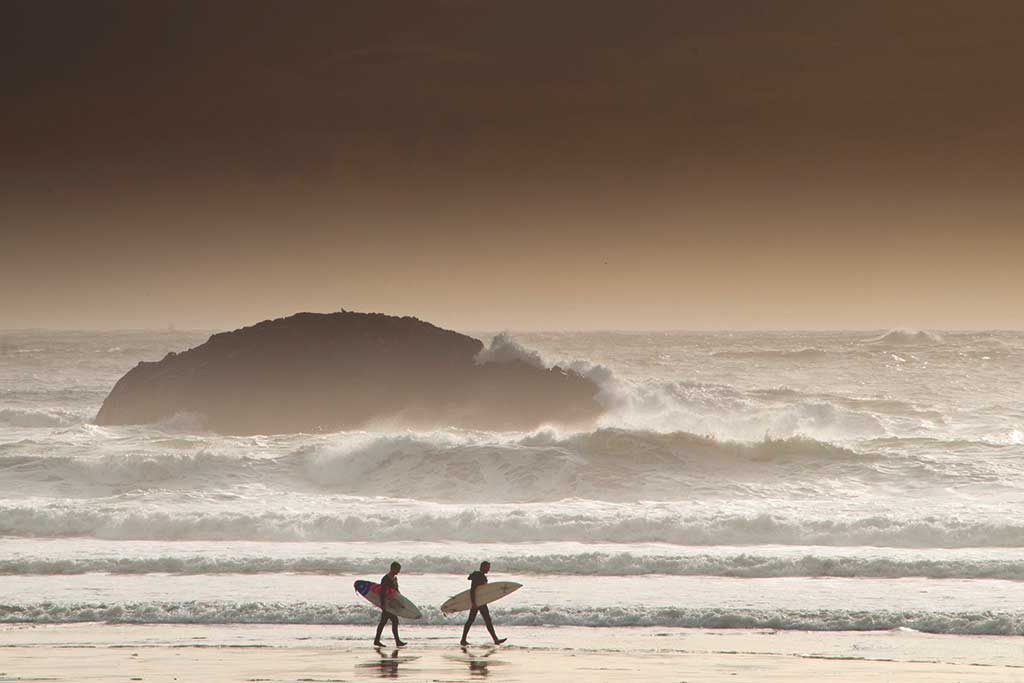

North Chesterman Beach credit Sander Jain
Since its first days, the Wick has been resolutely green. “I grew up here,” says McDiarmid. “This is my home and it deserves the respect that’s been fought so hard for.”
McDiarmid and his brother Bruce personally worked on situating the Inn’s two rustic buildings so they would minimize the need to remove any native plants. Those large trees that did come down are now incorporated in the walls of the Inn itself. Composting, electric service vehicles, local sourcing of provisions, and high-efficiency power systems are essential to the resort’s ethos. Low-slung and unostentatious, the Wick recedes into its environment, rather than calling attention to itself.
Similarly, its financial success has provided opportunities and inspiration for other local business people. “The last thing I’d want to be in a town like Tofino,” says McDiarmid, “is the rich guy pariah.” Instead, he’s been a pillar.
Former employees of the Wick have gone on to develop other tourism-related businesses, including fishing, kayaking, and whale and bear watching tour companies that are regularly recommended by the Inn’s concierge.
Local artists’ work is showcased throughout the resort and guests are encouraged to visit their studios and galleries in town.
Two former Wick restaurant team members have spread their business wings without flying out of the area. After serving at The Pointe, Nicholas Nutting opened The Wolf in the Fog (www.wolfinthefog.com) just a short stretch down the road, serving nightly feasts centered on locally fished and foraged ingredients. In 2014, it was named Canada’s best new restaurant in a national ranking.
The Wick also helped develop the local market for a range of lodging options, from mid-range places ike Jamie’s Rainforest Inn (www.tofinorainforestinn.com) and the Inn at Tough City (www.toughcity.com); to stunning private surfside digs like the cottage and suites at Chesterman Beach Bed & Breakfast (www.chestermanbeach.net), originally opened prior to the Wick, but refurbished and relaunched in 2003; and even another luxury property, Long Beach Lodge (www.longbeachlodgeresort.com), located just south of Tofino along Highway 4.
The Long Beach Lodge’s breathtaking yet comfortable seaview Great Room is a local must, featuring an enormous fire place, full bar with happy hour, frequent live music, and a menu that runs the gamut from hearth-baked pizza to Dungeness crab, which is caught in local waters year round.
Over a spread of locally caught salmon, oysters, and tuna tartare, Lodge chef Ian Riddick explained that, like Tofino’s other tourism-based businesses, the town’s restaurants interact more as community members than competitors.
“We all work together as part of the Tofino-Ucluelet Culinary Guild, which collectively buys and trucks in produce, meat, and seafood from small Vancouver Island suppliers,” he explains. “So we have access to the freshest products and they have a steady, reliable source of income.”
Individual households also participate in the guild, getting wholesale priced produce delivered weekly for home cooking. Typically Tofitian, it’s a wellhoned symbiosis of successful tourism and civic pride.
The local and the touristic blend almost as effortlessly as the waters of the sound and the ocean. At annual events, it’s often difficult to tell the residents from the guests. Late each September, the Queen of the Peak (www.queenofthepeak.com) all-female surfing competition draws a mix of nearby residents and far-flung athletes to Tofino’s chilly, choppy, world-class waves. It’s a blissful, sometimes blustery event on the rugged shoreline, marked by wetsuits and casual camaraderie.
The third week of November each year brings the Clayoquot Oyster Festival (www.oystergala.com), a favorite of locals and a major non-summer attraction. Started in 1997 as a one-night community activity to break the early winter doldrums, the festival has grown into a four-day bivalve bacchanal at the beginning of the oyster harvest season. Oyster farm tours, restaurant events, concerts, and all-youcan-slurp evenings showcase local cultivators and restaurateurs.
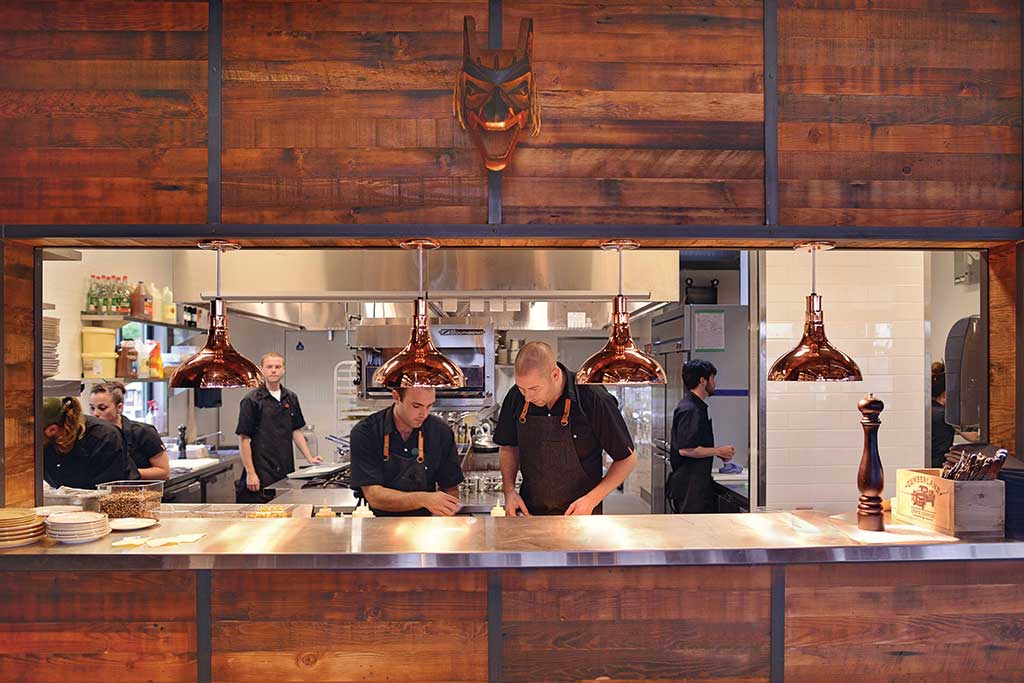

The Wolf In the Fog Kitchen Pass credit Chris Pouget
Residents and visitors alike flock to the surf in summer months, but, because of its temperate climate and alluring isolation, Tofino has had remarkable success in cultivating tourism all year round. November to February has become known as storm-watching season, drawing intrepid travelers to take in tempests at close proximity.
“The power of the ocean is spectacular,” says Lynda Kaye, owner of the Chesterman Beach Bed and Breakfast, describing the romantic appeal of huddling indoors by a roaring fire while watching the brooding sky and surging tides. Tumultuous rains and gale-force winds are typically interspersed with moments of stunning, quiet calm.
The Wick offers packages that specifically cater to storm tourists, providing not only in-room seaview soaking tubs, but rugged full-body raingear (hooded jackets, pants, boots) to encourage guests to venture outdoors and experience the elements f irst hand.
On mainland Vancouver to film A Series of Unfortunate Events in 2016, Neil Patrick Harris headed to Tofino for a 12th-anniversary celebration with husband David Burtka.
“I don’t think I’ve ever taken this many photos or videos of any place in my entire life,” Harris exulted in an Instagram post from Chesterman Beach, likely piquing the curiousity of many of NPH’s gay followers.
“The Mayor has been urging me to organize a gay pride event for years,” says Rino Del Zoppo. “And now I’m running a committee that’s trying to make it happen. But it would need to be special. Part of why I like it here is that it attracts a different kind of LGBT crowd. It’s not about clubs or a party atmosphere.”
“There are no dedicated LGBT social spaces here,” says Rino Del Zoppo, “But the town is very culturally aware and sophisticated. Attitudes are the complete opposite of what you might think about a place this far from any big city. I can’t think of any place in town a same-sex couple would feel uncomfortable hanging out or holding hands.
“Tofino attracts a lot of quirky people,” he enthuses. “The best sort of misfits.”


